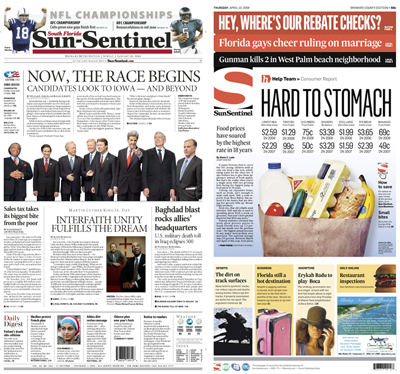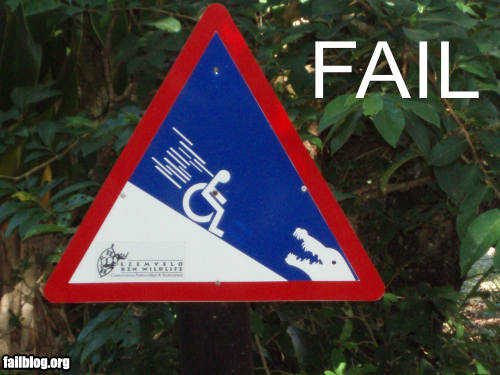The Politico will partner with several newspapers to deliver political news in exchange for ad placements. The Politico will also sell ads to national advertisers that will be placed in partner newspapers and sites in return for a share of revenue. Early partners include the Atlanta Journal-Constitution, Philadelphia Inquirer, Denver Post, and the Cleveland Plain Dealer.
People who complain that the implosion of the newspaper industry will create a vacuum in American democracy should perhaps take a harder look at The Politico. Launched just a little over 18 months ago as a specialized print/online/broadcast hybrid focused exclusively on politics, The Politico is reportedly profitable and has become a must-read for political junkies. Those folks are pretty desirable to advertisers. The company claims that it has more high-income and highly educated readers than Forbes.com or WSJ.com.
Lindsey McPherson of American Journalism Review takes a look at The Politco’s success. The venture has succeeded in attracting top journalists who are, by most accounts, turning out first-class work. While The Politico makes most of its revenue from a print edition distributed on an unusual schedule (three days a week, but only when Congress is in session), its business model is clearly to grow in all media in which it operates. The site features a mish-mash of articles, blogs, video and slide shows. While that kind of stuff is pretty typical fare for all newspaper sites these days, The Politico is different. Its tight focus on politics gives it a kind of nudge-nudge insider feel that adds edginess to its videos and thematic slide shows. You get the feeling that these guys know the inside scoop.
The Politico’s mission statement is a matter-of-fact explanation of why the collapse of newspapers has created a need for ventures like this. Born amid the early rounds of newspaper layoffs, the company promotes its journalists as brands, even encouraging them to peddle their work elsewhere. “Today, many of the reporters having the most impact are those whose work carries a unique signature, who add a distinct voice to the public conversation,” the mission statement says. “Their work, in other words, matters more than where they work.” The AJR article quotes several top reporters from major newspapers praising The Politico.
Game-changer
One of the most common complaints we hear about the death spiral of American newspapers is that it will leave an information gap. Citizens will no longer have the benefit of big Washington bureaus to investigate the government and keep government honest. While it’s true that decimated Capitol Hill news staffs will no longer send 100 journalists to cover the same Presidential press conference, there’s reason to take note of new models like The Politico’s.
Perhaps what will emerge is highly specialized news organizations that publish in whatever media make sense and that do one thing very well. Sites like Talking Points Memo and The Smoking Gun are already demonstrating that this model can work. These organizations will provide the same watchdog function as newspapers, but they won’t be distracted by the need to cover high school sports as well as Congressional committee meetings. As long as they attract the right audiences, the ad dollars will emerge to support them.
The idea of branding journalists ahead of media organizations is particularly noteworthy. We’re often asked what the future holds for professional journalists. Will there even be journalism jobs in the future? The answer is a resounding yes, but the new realities of the more competitive market will force journalists to be faster on their feet and more responsive. The cushy staff jobs are going away, and good riddance to them. There will still be a need and a market for good reporters, but the people who succeed will be the ones who work in a variety of media for a variety of bosses, moving quickly between assignments and selling to the highest bidder. They will be adept at promoting themselves as the brand rather than their employers. A few prominent journalists have done this in the past. In the future, nearly all will need to work this way. The Politico recognizes this and that’s why it may be an early glimpse at the future of news media.
Googling the Morgue
Continuing on its campaign to digitize the known body of human knowledge so that it can sell ads against it, Google announced a campaign to scan and index pre-digital age newspapers. The company has partnered with about 100 newspapers to digitize their archives. The venture will use technology developed for Google’s two-year-old book scanning project that figures out what articles are about and serves other relevant content – as well as ads – against them. Google used the 1969 moon walk as an example of the kind of pre-Internet content it will make available to the world. We just hope it doesn’t fail to include this classic from The Onion.
Newspaper In Your Pocket – Almost
E-ink continues to evolve to the applause of a newspaper industry desperately seeking an alternative to costly newsprint. Plastic Logic used the Demo conference to introduce its electronic newspaper reader. The device is slim, lightweight and big enough to display a full page of a newspaper. The Plastic Logic Reader uses a flexible plastic display that’s about the size of a standard sheet of paper, or 2.5 times as large as Amazon’s Kindle. The big advantage is the slim profile and light weight. The reader comes the closest of any electronic device to being truly portable. However, it hasn’t yet achieved the Holy Grail of the e-ink industry: a display you can roll up and stash in your pocket. That’s coming, officials say, but it’ll be at least a couple of more years. E-Ink Corp. has been working toward this goal for more than a decade and its research is now bearing some commercial fruit. You can see a demo video on Plastic Logic’s home page.
And Finally…
Ink-stained wretches who complain that industry layoffs hit working stiffs the hardest can perhaps take some satisfaction in Gannett’s announcement of consolidation moves that will eliminate 100 management positions around the company. Circulation, finance and some other functions that are common across Gannett properties will be merged into regional groups, with some managers getting promotions and others getting the door. The cuts are in addition to the 1,000 people just laid off.






